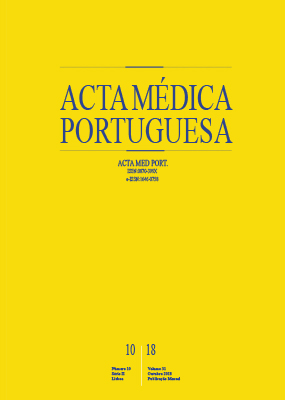Tendências Epidemiológicas das Fraturas do Fémur Proximal na População Idosa em Portugal
DOI:
https://doi.org/10.20344/amp.10464Palavras-chave:
Fraturas do Colo Femoral/epidemiologia, Idoso, Osteoporose/complicações, PortugalResumo
Introdução: As fraturas do fémur proximal representam um problema de saúde pública nas sociedades industrializadas. São escassos os estudos sobre a incidência destas fraturas em Portugal. O objectivo deste estudo foi analisar e interpretar as tendências epidemiológicas das fraturas do fémur proximal, na população idosa em Portugal, no período de 2005 a 2013.
Material e Métodos: Estudo transversal incluindo todos os doentes com idade igual ou superior a 65 anos admitidos por fratura do fémur proximal em hospitais portugueses pertencentes ao serviço nacional de saúde com recurso aos dados do registo nacional da administração central do sistema de saúde.
Resultados: Foram incluídos 101 436 doentes. Observou-se um aumento progressivo no número de internamentos por ano ao longo do período analisado. A idade média à admissão foi de 79,32 (± 12.33) anos apresentando um aumento progressivo e significativo ao longo do período analisado (p < 0,001). Dos doentes, 74.5% eram do sexo feminino (p < 0,001). Apresentavam idade média à admissão significativamente superior, quer globalmente, quer em cada ano em estudo (p < 0,001). A incidência ajustada à idade (≥ 65 anos) foi de 597 fraturas / ano / 100 000 habitantes. Verificou-se um aumento na incidência de fraturas do fémur proximal de 508,49 (2005) para 628,39 fraturas por 100 000 pessoas / ano (2013). No sexo feminino o aumento foi de 616,78 para 762,88 e no masculino de 339,95 para 419,06.
Discussão: Este é o primeiro estudo a avaliar e interpretar as tendências epidemiológicas das fraturas do fémur proximal em doentes admitidos nos hospitais do Serviço Nacional de Saúde em Portugal incluindo apenas indivíduos com idade igual ou superior a 65 anos.
Conclusão: O número absoluto de fraturas do fémur proximal em Portugal mostrou uma tendência de aumento entre 2005 - 2013, afetando uma percentagem significativa da população portuguesa com mais de 65 anos de idade. Tendem a ocorrer mais comummente no sexo feminino e em indivíduos progressivamente mais velhos.
Downloads
Downloads
Publicado
Como Citar
Edição
Secção
Licença
Todos os artigos publicados na AMP são de acesso aberto e cumprem os requisitos das agências de financiamento ou instituições académicas. Relativamente à utilização por terceiros a AMP rege-se pelos termos da licença Creative Commons ‘Atribuição – Uso Não-Comercial – (CC-BY-NC)’.
É da responsabilidade do autor obter permissão para reproduzir figuras, tabelas, etc., de outras publicações. Após a aceitação de um artigo, os autores serão convidados a preencher uma “Declaração de Responsabilidade Autoral e Partilha de Direitos de Autor “(http://www.actamedicaportuguesa.com/info/AMP-NormasPublicacao.pdf) e a “Declaração de Potenciais Conflitos de Interesse” (http://www.icmje.org/conflicts-of-interest) do ICMJE. Será enviado um e-mail ao autor correspondente, confirmando a receção do manuscrito.
Após a publicação, os autores ficam autorizados a disponibilizar os seus artigos em repositórios das suas instituições de origem, desde que mencionem sempre onde foram publicados e de acordo com a licença Creative Commons









